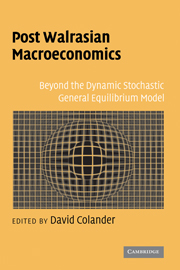Book contents
- Frontmatter
- Contents
- List of Contributors
- Foreword by Alan Kirman
- Introduction
- PART I WHERE WE ARE IN MACRO AND HOW WE GOT THERE
- PART II EDGING AWAY FROM THE DSGE MODEL
- PART III LEAPING AWAY FROM THE DSGE MODEL
- PART IV LETTING THE DATA GUIDE THEORY
- 12 The Past as the Future: The Marshallian Approach to Post Walrasian Econometrics
- 13 Old World Econometrics and New World Theory
- 14 Four Entrenched Notions Post Walrasians Should Avoid
- 15 Confronting the Economic Model with the Data
- 16 Extracting Information from the Data: A European View on Empirical Macro
- PART V POLICY IMPLICATIONS
- Bibliography
- Index
14 - Four Entrenched Notions Post Walrasians Should Avoid
Published online by Cambridge University Press: 02 December 2009
- Frontmatter
- Contents
- List of Contributors
- Foreword by Alan Kirman
- Introduction
- PART I WHERE WE ARE IN MACRO AND HOW WE GOT THERE
- PART II EDGING AWAY FROM THE DSGE MODEL
- PART III LEAPING AWAY FROM THE DSGE MODEL
- PART IV LETTING THE DATA GUIDE THEORY
- 12 The Past as the Future: The Marshallian Approach to Post Walrasian Econometrics
- 13 Old World Econometrics and New World Theory
- 14 Four Entrenched Notions Post Walrasians Should Avoid
- 15 Confronting the Economic Model with the Data
- 16 Extracting Information from the Data: A European View on Empirical Macro
- PART V POLICY IMPLICATIONS
- Bibliography
- Index
Summary
Any hypothesis must be tested on all points of observational fact.
Patrick HurleyIt takes two to speak the truth, – one to speak, and another to hear.
Henry David ThoreauThe introduction to this volume on Post Walrasian macroeconomics takes me back to my graduate student days of the early 1950s. At that time, I was pursuing two research programs and formal studies towards doctoral degrees in agricultural economics and statistics. Inspired by Samuelson (1948, Chapter V, esp. pp. 117–22) on current prices affecting the parameters of indifference maps containing money as a commodity and by Scitovsky (1945), Lange (1940), Ichimura (1951) and Tintner (1952a) on shifts of demand produced by more general sorts of cause affecting indifference maps, I found much satisfaction in challenging the widely expressed fear that acceptance of such ideas would wreak havoc with economics, Scitovsky (1945, p. 100). The papers by Haavelmo (1947) and Girshick and Haavelmo (1947) drew my research in statistics into tackling some unsolved puzzles in the budding econometric statistics of macroeconomics. In particular, Haavelmo (1947), on the marginal propensity to consume, revealed the forms of the exact finite sample distributions of maximum likelihood estimators and test statistics associated with the Keynesian consumption function, Basmann (1974, pp. 214–18).
The prospect suggested in the introduction of developing an adequate agent-based macroeconometrics is of special interest to me. In the 1950s, my dissertation supervisor, Gerhard Tintner, had taken an interest in problems of aggregating individual demand functions.
- Type
- Chapter
- Information
- Post Walrasian MacroeconomicsBeyond the Dynamic Stochastic General Equilibrium Model, pp. 277 - 286Publisher: Cambridge University PressPrint publication year: 2006



